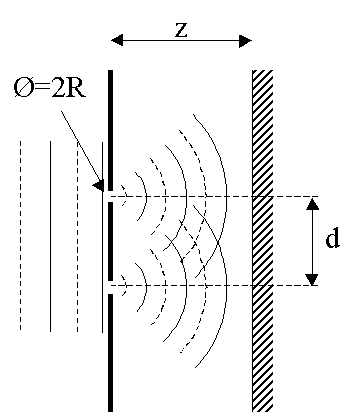7.1.1. Young’s experiment.
When a screen with two small holes is illuminated by a monochromatic, plane wave an interference pattern can be observed on a screen at a sufficient large distance from the screen with the holes.

The following python script simulates Young’s experiment:
from LightPipes import *
import matplotlib.pyplot as plt
"""
Young's experiment.
Two holes with radii, R, separated by, d, in a screen are illuminated by a plane wave. The interference pattern
at a distance, z, behind the screen is calculated.
"""
wavelength=5*um
size=20.0*mm
N=500
z=50*cm
R=0.3*mm
d=1.2*mm
F=Begin(size,wavelength,N)
F1=CircAperture(R/2.0,-d/2.0, 0, F)
F2=CircAperture(R/2.0, d/2.0, 0, F)
F=BeamMix(F1,F2)
F=Fresnel(z,F)
I=Intensity(2,F)
s1 = r'LightPipes for Python ' + LPversion + '\n'
s2 = r'Young.py'+ '\n\n'\
f'size = {size/mm:4.2f} mm' + '\n'\
f'$\\lambda$ = {wavelength/um:4.2f} $\\mu$m' + '\n'\
f'N = {N:d}' + '\n'\
f'd = {d/mm:4.2f} mm distance between the holes' + '\n'\
f'R = {R/mm:4.2f} mm radius of the holes' + '\n'\
f'z = {z/mm:4.2f} mm distance to screen' + '\n'\
r'${\copyright}$ Fred van Goor, June 2020'
fig=plt.figure(figsize=(9,9));
ax1 = fig.add_subplot(211);ax1.axis('off')
ax2 = fig.add_subplot(212);ax2.axis('off')
ax1.imshow(I,cmap='rainbow');ax1.set_title('intensity pattern')
ax2.text(0.0,1.0,s1,fontsize=12, fontweight='bold')
ax2.text(0.0,0.5,s2)
plt.show()
Results:
(Source code, png, hires.png, pdf)
